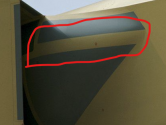I thought Wanghai was the 9th?
Either way it looks like the formation lights have been upgraded. Possibly they’ve upgraded the avionics as well.
It doesn't look like just a simple banding to me.It is jpeg compression artifact. The artifact is more pronounced on a fine luminance or color gradient surface such as the DSI or a ball in dark lightning. It can also be easily noticed in a dark scene in a highly compressed video, otherwise the video would look perfect in bright scene.
I thought Wanghai was the 9th?
Either way it looks like the formation lights have been upgraded. Possibly they’ve upgraded the avionics as well.
The picture is 1920x1080, size is 203KB. A photo of the same dimension taken by my mobile phone is 1.3MB. So the picture is highly compressed, similar to low bit rate in video, therefor subject to strong artifact.It doesn't look like just a simple banding to me.
Those banding mostly visible on video with low bit rate.
The other part of the picture does not have similar gradient. Gradience is a function of curvature. Fine gradience means the color and/or luminance changes in very fine small steps due to the curve, it is more pronounced in a curvy surface (DSI), not on a flat or near flat surface (the other part of the aircraft).And I don't see the same banding on other part of picture with similar color gradient.

"The waterbed effect of the inflatable DSI works therapeutically for the boundary layer, convincing air molecules to enter the air intake without disturbance, thus providing an extra 10% thrust in all flight regimes"Indeed, worlds first inflatable DSI.
The F-22's cost model is outdated, but its research and development model is very similar to that of J-20 and still has reference value.You can't get an accurate F-22 cost because it's been out of production for so long.
The F-35 costs I've used are for the Air Force Variant and are the flyaway costs excluding R&D
The F-22's cost model is outdated, but its research and development model is very similar to that of J-20 and still has reference value.
However, unless Lockheed Martin announces the details of the research and development cost sharing of the three sub-models of F-35, it will be difficult for outsiders to clearly distinguish them. The F-35 project was developed and marketed as a joint project that simultaneously meets the needs of three branches of the US military. Its unit price includes not only the amortization of research and development costs, but also wider after-sales services than previous aircraft, and there was a negotiation game in the context of a single supplier's monopoly scene. Its cost model should be very different from that of J-20.
The U.S. military did not pay for the F-35's R&D costs separately, so even the flyaway cost cannot be completely exclusive of R&D costs. If the maintenance cost is contracted separately, then it does not need to be taken into consideration.The F-35 unit costs I used were very clear these are the flyaway costs without any R&D component.
The F-35 operating costs are also accounted for separately and were $4.1 Mn annually as of 2021.

